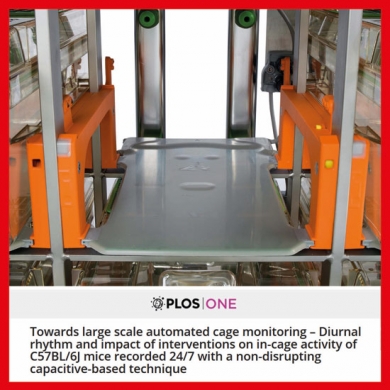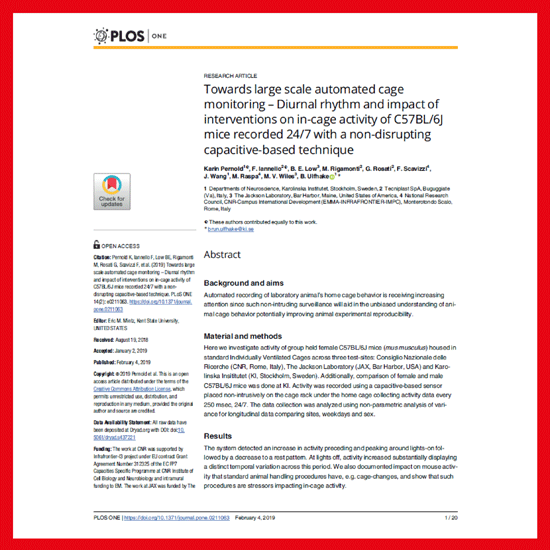
The current version of the Tecniplast website doesn't match your region. Please visit your local website to find information and offerings specific to your country.

The current version of the Tecniplast website doesn't match your region. Please visit your local website to find information and offerings specific to your country.


An interesting article “Towards large scale automated cage monitoring – Diurnal rhythm and impact of interventions on in-cage activity of C57BL/6J mice recorded 24/7 with a non-disrupting capacitive-based technique” has been recently published on PLOS One (Click here to read the article), a peer-reviewed open access scientific journal published by the Public Library of Science (PLOS) since 2006. The journal covers primary research from any discipline within science and medicine.
The authors investigated activity of group held female C57BL/6J mice (mus musculus) housed in standard Individually Ventilated Cages across three test-sites: Consiglio Nazionale delle Ricerche (CNR, Rome, Italy), The Jackson Laboratory (JAX, Bar Harbor, USA) and Karolinska Insititutet (KI, Stockholm, Sweden). They wanted to investigate how DVC® can improve animal experimental reproducibility, especially considering the fact that automated recording of laboratory animal’s home cage behavior is receiving increasing attention since non-intruding surveillance will aid in the unbiased understanding of animal cage behavior.
 Conclusions of the study demonstrate the potentiality of the DVC® as a scalable home cage monitoring system that can provide complementary information for animal welfare, experimental design and phenotype characterization. Results are promising for the DVC®. Indeed The system detected an increase in activity preceding and peaking around lights-on followed by a decrease to a rest pattern. At lights off, activity increased substantially displaying a distinct temporal variation across this period.
Conclusions of the study demonstrate the potentiality of the DVC® as a scalable home cage monitoring system that can provide complementary information for animal welfare, experimental design and phenotype characterization. Results are promising for the DVC®. Indeed The system detected an increase in activity preceding and peaking around lights-on followed by a decrease to a rest pattern. At lights off, activity increased substantially displaying a distinct temporal variation across this period.
Authors also documented the impact of standard animal handling procedures (e.g., cage-changes) on animal activity and show that such procedures are stressors impacting in-cage activity. Overall, authors shown the potentiality of DVC® in extracting valuable in-cage animal behaviour data that would not be available without home cage monitoring techniques.
Click here to download the full article, or visit our Product Page to find out more about Tecniplast Digital Ventilated Cage.